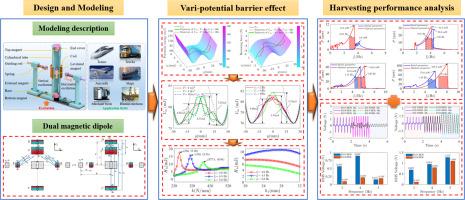Electromagnetic vari-potential bi-stable energy harvester under low-amplitude excitation
IF 9.4
1区 工程技术
Q1 ENGINEERING, MECHANICAL
International Journal of Mechanical Sciences
Pub Date : 2025-09-24
DOI:10.1016/j.ijmecsci.2025.110871
引用次数: 0
Abstract
This study proposes a novel electromagnetic vari-potential bi-stable energy harvester (EM-VBEH). The potential barrier of the primary oscillator can be dynamically adjusted by an external spring-magnetic oscillator to form a vari-potential barrier effect (VPBE), which enables the harvester to achieves large amplitude inter-well motion under low-frequency and weak-amplitude excitation, significantly improving output power and bandwidth. A mathematical model of the EM-VBEH is established based on the dual-magnetic dipole theory. The VPBE is validated by tracking response trajectories on potential energy and restoring force surfaces, and the influence of system parameters on the dynamic potential barrier is quantitatively analyzed. Frequency and amplitude sweeping dynamics reveals rich nonlinear behaviors of the system, including intra-well harmonic, inter-well harmonic and subharmonic orbits, as well as chaotic motion. Compared to the traditional electromagnetic fixed-potential bi-stable energy harvesters (EM-FBEHs), the EM-VBEH exhibits significant advantages: the inter-well excitation threshold is reduced by 45 %, the inter-well bandwidth is expanded by over 1.65 times, and the maximum average power is increased by approximately 10 times under low-excitations. The performance of EM-VBEH is optimized by using genetic algorithm, and the maximum output power and half-power bandwidth are increased by 42.77 % and 19.58 %. The results of fixed-frequency and frequency-sweep experiments indicate that compared to the EM-FBEH, both the inter-well voltage and bandwidth of the EM-VBEH have multiple-fold increases under weak excitations. Simultaneously, the accuracies of the theoretical model and numerical simulations are validated. The proposed EM-VBEH provides an innovative solution for efficient and broadband energy harvesting from low-frequency, weak-amplitude vibrations.

低幅激励下的电磁变电位双稳能量采集器
本研究提出一种新型电磁变电位双稳态能量采集器(EM-VBEH)。主振荡器的势垒可以通过外置弹簧磁振荡器动态调节,形成变势垒效应(VPBE),使采集器在低频弱幅激励下实现大幅度井间运动,显著提高输出功率和带宽。基于双磁偶极子理论,建立了EM-VBEH的数学模型。通过跟踪势能响应轨迹和恢复力面对VPBE进行了验证,并定量分析了系统参数对动态势垒的影响。频率和振幅扫描动力学揭示了系统丰富的非线性行为,包括井内谐波、井间谐波和亚谐波轨道,以及混沌运动。与传统的电磁固定电位双稳态能量采集器(em - fbeh)相比,EM-VBEH具有显著的优势:在低激励下,井间激励阈值降低了45%,井间带宽扩大了1.65倍以上,最大平均功率提高了约10倍。采用遗传算法优化了EM-VBEH的性能,最大输出功率和半功率带宽分别提高了42.77%和19.58%。固定频率和扫频实验结果表明,在弱激励下,与EM-FBEH相比,EM-VBEH的井间电压和带宽都有数倍的提高。同时,对理论模型和数值模拟的准确性进行了验证。EM-VBEH提供了一种创新的解决方案,可以从低频、弱振幅振动中高效、宽带地收集能量。
本文章由计算机程序翻译,如有差异,请以英文原文为准。
求助全文
约1分钟内获得全文
求助全文
来源期刊

International Journal of Mechanical Sciences
工程技术-工程:机械
CiteScore
12.80
自引率
17.80%
发文量
769
审稿时长
19 days
期刊介绍:
The International Journal of Mechanical Sciences (IJMS) serves as a global platform for the publication and dissemination of original research that contributes to a deeper scientific understanding of the fundamental disciplines within mechanical, civil, and material engineering.
The primary focus of IJMS is to showcase innovative and ground-breaking work that utilizes analytical and computational modeling techniques, such as Finite Element Method (FEM), Boundary Element Method (BEM), and mesh-free methods, among others. These modeling methods are applied to diverse fields including rigid-body mechanics (e.g., dynamics, vibration, stability), structural mechanics, metal forming, advanced materials (e.g., metals, composites, cellular, smart) behavior and applications, impact mechanics, strain localization, and other nonlinear effects (e.g., large deflections, plasticity, fracture).
Additionally, IJMS covers the realms of fluid mechanics (both external and internal flows), tribology, thermodynamics, and materials processing. These subjects collectively form the core of the journal's content.
In summary, IJMS provides a prestigious platform for researchers to present their original contributions, shedding light on analytical and computational modeling methods in various areas of mechanical engineering, as well as exploring the behavior and application of advanced materials, fluid mechanics, thermodynamics, and materials processing.
 求助内容:
求助内容: 应助结果提醒方式:
应助结果提醒方式:


